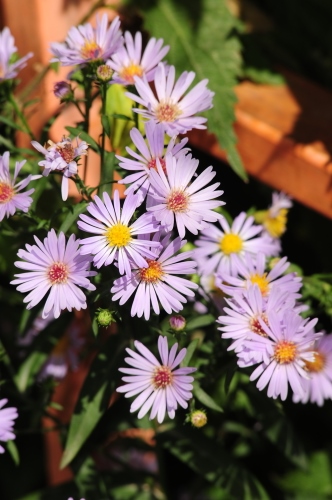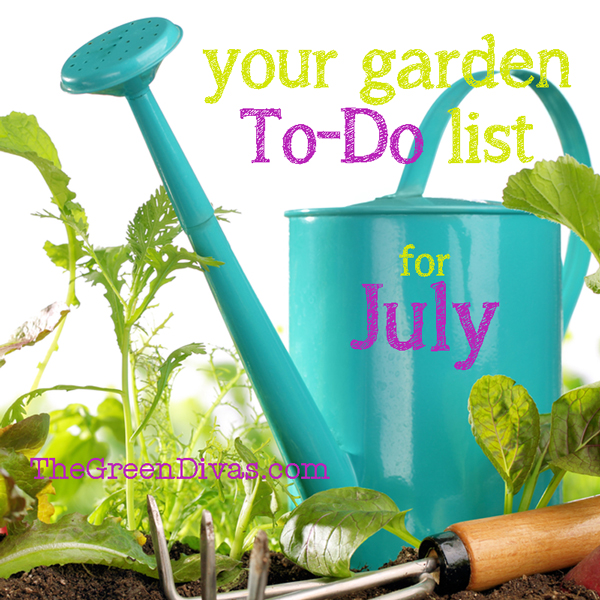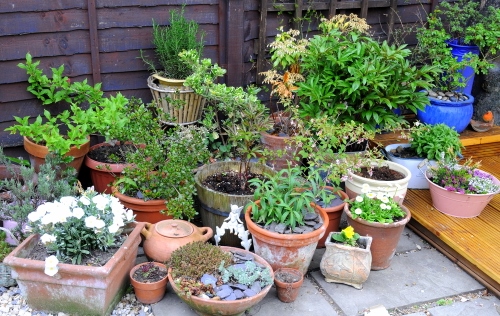The fruits of our gardening labors are literally in our hands this month.
Harvests of early tomatoes, corn, squash, herbs to enjoy along with bouquets of flowers for the house and garden…
Be careful to avoid working in the hottest part of the day and be sure to drink plenty of water while gardening. Hats, sunglasses, sunscreen, bug spray and loose long sleeves are musts for me.
Listen to this Green Divas In The Garden podcast segment for July gardening tips…
What to Plant
Vegetables and fruit—Green beans, corn, beets, Swiss chard, spinach, kale and leaf lettuce can be planted now where there are bare areas in the garden. Start transplants from seed (under lights indoors) for broccoli, cabbage, cauliflower, peppers and tomatoes for the fall garden. They can be set out at the end of July. Refresh the soil before planting by digging in some compost.
Container grown annuals, roses, ground covers, vines and perennials—Plant annuals from your local independent garden center (be sure they don’t treat their plants with bee-killing neonicotinoids) and fill gaps where ephemeral perennials have gone for the year.
Container-grown roses can be planted all summer. Did you know that if you’re cutting roses for the house, you should cut just above an outward-facing five or seven leaflet just above a bud eye? This helps the plant continue to put on new buds. Plant container-grown ground covers and vines now, being sure to carefully water.
Container grown shrubs and trees can be planted now, but there are better times (like the fall) to do so. I would make plans now and wait for fall to plant.
What to Harvest
Early tomatoes, cucumbers, green beans, sweet corn, zucchini and other summer squash (and flowers) when they are small,“baby,” peppers, baby carrots, herbs including basil, thyme, tarragon, and oregano, broccoli (main heads, leave side shoots for additional harvests), onions (lift them and allow to dry out for a week to 10 days.) Blueberries and raspberries are ready for harvest now.
July Care
Water most things slowly and deeply as needed. Careful watering—just the right amount and in the right place, will make a huge difference in the quality of your harvest and the health of your garden overall. Vegetables need an inch of water per week, perennials and lawns should be watered only if they are wilting, bulbs don’t like too much water and can rot in a typical garden with timed “automatic” irrigation.
Soaker hoses are best for shrubs. Of course, watering trees is very important, especially in the first two years after planting. Containers and shallow-rooted plants like blueberries will need to be watered daily. If you’re in the area, I recommend the seminar on watering being offered at the Chicago Botanic Garden. Click here to register.
Continue to weed on a regular basis. Try to catch weeds before they go to seed so you have fewer weeds in the next cycle.
Fertilize by adding compost, if needed. Do not fertilize trees at this time of year. Fertilizing trees will cause them to put on a lot of lush growth which may not harden off properly before cold temperatures arrive.
Remove overripe fruits and vegetables if applicable to avoid attracting disease and insects unnecessarily. This will also keep the plant producing.
Put straw under pumpkins, melons and squash as they ripen so they don’t contact the soil beneath them and rot. You can also place the mature fruit on flower pots, as long as the air can circulate under and around them.

Avoid working in your garden in heavy dew.Certain diseases can spread if you are working with the plants or soil when they are wet.
Monitor plants for signs of insects* and diseases on a regular basis. It’s best to catch an invasion early to avoid having to roll out the heavy chemicals. Organic gardening best practices focus on using cultural (spacing, crop rotation, pruning and others) mechanical (hand-picking, birdhouses, row covers, sticky traps and others) and, only as a last resort, natural insecticides to maintain plant health. I find Japanese beetles easiest to control by hand picking and dunking in soapy water. For a great reference, I recommend the series by Mother Earth News here.
Continue deadheading (remove spent blossoms) to keep plants blooming. You may want to chop your zinnias, petunias and other annuals that are growing out to a shorter length. This will keep them looking fresh through the rest of the growing season. Do the same for catmint, asters, salvia and veronicas for another flush of bloom.
Groom plants (remove yellow leaves, broken stems) to keep everything healthy and looking well. Continue pinching the tips of your hardy mums every two weeks till the Fourth of July for optimal mounds full of blooms in the fall. You can also pinch asters in a similar fashion.
Stake tall plants. Continue typing up vines to structures as they grow.
Spring-flowering bulbs can be lifted and divided now for replanting, now that the foliage has ripened to yellow.
Pruning—There’s still time to prune your hedges this year. Be sure to leave hedges wider at the bottom than the top so sun can get to the bottom branches. This is also a good time to prune your wisteria vine. Cut raspberries canes that have borne fruit this year down to the base. Leave 10-12 new canes for each plant.
* Tomato hornworms, cucumber beetles, Mexican bean beetles, squash vine borer, sap beetles, Colorado potato beetles… I haven’t seen many of these in my garden and those I do see I have been able to control with Bt. The birds are tremendously helpful. I have bluebirds, robins and wrens visiting the vegetable garden.
Bonus!
Check out The Green Divas new podcast series, GD Spirit Pub! Listen to the pilot episode and learn more about the show … here!


Pingback: SNAP SNAFU
Andrew
July 30, 2018 at 3:42 pm
What are some of your go-to plant species?